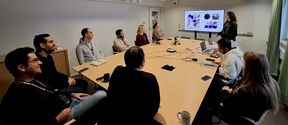Black holes might be nicer than we think

They’re big, powerful and—let’s face it—a little scary. If there’s anything in our universe that could cause ultimate destruction, it’s a black hole.
Yet these giant sinkholes in space are believed to be at the centre of all massive galaxies. In fact, they play such a big role that one criterion for calling a galaxy active is whether the black hole at its core is actively shooting matter.
Say what? That’s right. It turns out that black holes don’t just use super strong force to pull particles and light in; they can create jets that shoot plasma so far, it touches the next galaxy.
Observational astronomers—the scientists tasked with documenting what can be seen in space—are busy figuring out why.
A helping hand
In principle, it’s easy for galaxies to grow: a star is born when gas cools down. Yet the data available points to a paradox, with the most carefully tested calculations saying there should be more stars than actually appear. So something must be happening along the way—some mechanism is keeping star formation at a certain, perhaps manageable level, while galaxies evolve.
Current thinking points to black holes as the most likely helper.
‘Bipolar plasma jets from the black hole seem to act as a kind of thermostat for the entire galaxy,’ says Tuomas Savolainen, Academy Research Fellow at Aalto University. ‘In the last twenty years or so, there’s been a lot of work that suggests these jets mechanically heat up gas that might otherwise form new stars. What we still don’t know is how the jets, which are very narrow, are able to distribute the energy created by black holes over such a big area.’
Big is right. According to Tuomas, sending plasma in two directions, these jets can stretch millions of light years in length.

Seeing the unseeable
While black holes might lend a helping hand, they are tricky. They absorb all light so they can’t really be seen in the way we see planets or stars nearby. One tip-off can be plasma jet streams. But even when they are present, the regions where they form are relatively small and, seen from Earth, incredibly far away. Case in point: one of the closest massive black holes that is active, located at the centre of our neighbouring galaxy M87, is more than 50 million light years away.
Researchers have been forced to get creative. One ongoing project combines the power of radio telescopes around the globe—and one in space. The technique, called Very Long Baseline Interferometry, amounts to a telescope bigger than our planet at 350,000 km-long. Harnessing its strength, the team has been able to study the jet at the centre of nearby giant galaxy, Perseus A, with unprecedented accuracy.
Another major international collaboration uses powerful, shorter-wavelength telescopes in the same way, in hopes of a better view of our own galaxy’s black hole—or rather, its shadow on the light behind. The Event Horizon Telescope Collaboration produces a view so refined that, from basically anywhere on Earth, you could spot an Oreo cookie on the surface of the moon.
Tuomas SavolainenWe’re trying to push the limits of what we can see
‘We’re trying to push the limits of what we can see,’ says Tuomas, who is part of both ongoing studies through his work at Aalto’s Metsähovi Radio Observatory.
This means getting up close and personal, at least as to the degree that technology can provide. Exquisite resolution can show us where plasma jets actually start. It’s also the key to capturing things that have never been seen, like the shadow of a black hole, which is essentially a gravitationally lensed image of the point of no return, more formally known as the event horizon.
Refining the refined
Though with every decade our view reaches deeper into space, black hole jets remain elusive.
‘We still don’t properly understand how these plasma jets are formed,’ explains Tuomas. ‘We know that there are magnetic forces at play and some rotation, as well. But we aren’t sure about how black holes are able to generate these huge jets.’
‘Knowing how jets are launched would tell us why some black holes shoot plasma, and why others don’t. Essentially we’d be able to name the conditions needed to turn on galaxy heating—and, by extension, understand what jets means for galaxy evolution.’
More from our Way Out There series

Black holes might be nicer than we think
They’re giant, destructive vacuums with the power to rip stars apart, yet evidence points to the helpful role black holes also play as galaxies form.
Send it up, up and away? Maybe not, space junk is a problem!
Clearing up the world’s space junk can pave the way for better mobile infrastructure and other ways to move into space
Secrets of our universe live in a big blue cylinder
There isn’t much on Earth but you can find it just about everywhere else — how a type of helium might tell us how everything we know got its start.
Dim light from far-away galaxies deserves a second look
Radio waves are being picked up from galaxies long considered to be silent. What’s up?Read more news
Apply to be a guest professor or visiting researcher at the Université Grenoble Alpes
Unite! partner, Université Grenoble Alpes (UGA) has opened a call to host international professors and researchers for short stays.
Floriane presents research findings on denim recycling
On 15 January 2026, Floriane Jacquin, an intern with the Textile Chemistry Group at Aalto University, presented the findings.
Postdoctoral researcher Eloi Moliner makes history as a 5-time award winner
Eloi Moliner is one of the most decorated doctoral researchers in Aalto University's history – we would like to highlight his success and contributions to the field of audio signal processing






